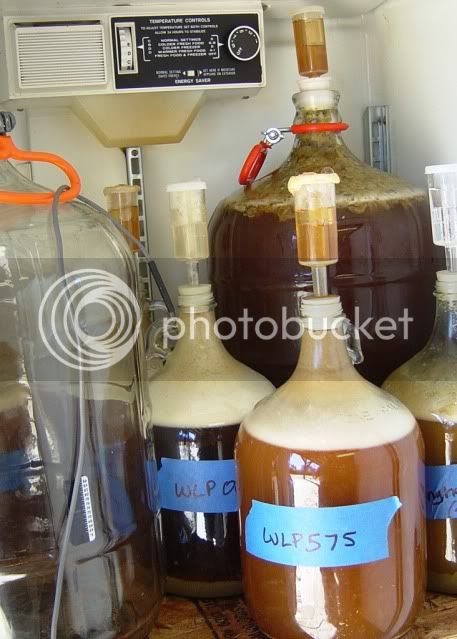JuanMoore
Getting the banned back together
I recently decided to try a little expiriment to compare a few different types of yeast. I wanted to get a clear picture as to what different flavors each yeast created, so that I could choose the yeast that might best compliment a particular recipe. The idea came to me when I was reading about SMaSH brewing, and I thought this would add another dimension to that concept.
I decided on an IPA, because that is probably the style I will be brewing most often, and brewed a 5 gal batch using pale malt, one specialty malt, and only one hop variety. After cooling and aerating the whole batch, I then split the wort into 5 one gallon jugs, and pitched a different yeast to each one. I used 1 dry yeast, 2 liquid Ca yeasts, and 2 liquid Belgian yeasts.
It's still a few days away from being ready to bottle, but I've already seen some enlightening things. The most interesting thing is the huge differences in color. Even though they all started out the same color, the color and turbidity during fermentation was greatly varied. They ranged from almost no color change from the original wort, to a murky greenish brown, to a bright orange.
The lag-times were almost identical, and all the fermentations seem to be on a very similar schedule. I've been rotating the bottles inside my fermentation fridge daily to even out any temperature differences there might be between the back and front, left and right, etc.
Now that fermentation is almost over, they have all returned to a color similar to the original wort, but there are still noticeable differences between them. I took some pictures, but it seems that I don't have enough posts under my belt yet to be able to show them. I'll try share the pictures and results soon.
Has anyone ever heard of the yeast strain having a significant impact on the color of the finished beer? Do you think the colors will all equalize by the time fermentation is complete?
I decided on an IPA, because that is probably the style I will be brewing most often, and brewed a 5 gal batch using pale malt, one specialty malt, and only one hop variety. After cooling and aerating the whole batch, I then split the wort into 5 one gallon jugs, and pitched a different yeast to each one. I used 1 dry yeast, 2 liquid Ca yeasts, and 2 liquid Belgian yeasts.
It's still a few days away from being ready to bottle, but I've already seen some enlightening things. The most interesting thing is the huge differences in color. Even though they all started out the same color, the color and turbidity during fermentation was greatly varied. They ranged from almost no color change from the original wort, to a murky greenish brown, to a bright orange.
The lag-times were almost identical, and all the fermentations seem to be on a very similar schedule. I've been rotating the bottles inside my fermentation fridge daily to even out any temperature differences there might be between the back and front, left and right, etc.
Now that fermentation is almost over, they have all returned to a color similar to the original wort, but there are still noticeable differences between them. I took some pictures, but it seems that I don't have enough posts under my belt yet to be able to show them. I'll try share the pictures and results soon.
Has anyone ever heard of the yeast strain having a significant impact on the color of the finished beer? Do you think the colors will all equalize by the time fermentation is complete?




